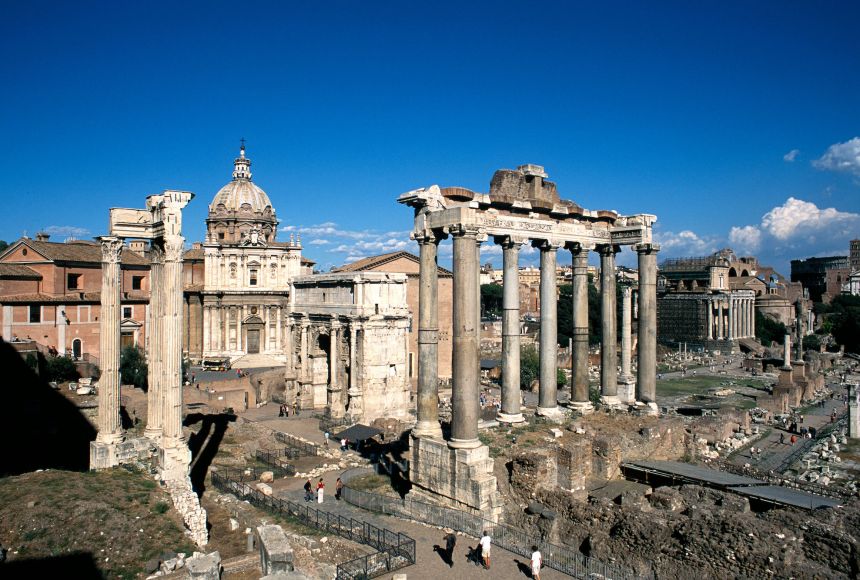In the sixth century B.C.E., the city of Rome was ruled by the Etruscans. They were a wealthy and powerful civilization from the north of Italy. In 509 B.C.E., Romans overthrew the Etruscan king and founded the Roman Republic.
A Republic: Power to the People!
Rome's first government was a representative democracy. Its citizens, who only could be free, adult males, elected representatives to rule on their behalf. Initially, Rome's wealthiest families, the patricians, had all the power, and only they could hold political or religious offices. Every other free Roman citizen was a plebeian. No plebeians could hold office. Only Rome's enslaved were below the plebeians. Over the next 200 years, the plebeians fought for and gained power within the government.
At the heart of the Roman Republic was the Senate, the sole governing body. Although the Senate did not make laws, it had great influence over Rome's law-making bodies.
Assemblies Share Power
The Senate lasted as a sole governing body only for about 15 years. In 494 B.C.E. the plebeians organized a strike. In response, the Senate established the Concilium Plebis, or the Council of the Plebs. Plebeians got a voice in the government, and new legislative bodies were formed. Called assemblies, these legislative bodies shared power with the Senate.
An assembly called the Comitia Centuriata made decisions about war, passed laws, and elected magistrates, or high officials. They also considered appeals of death sentences and conducted foreign relations.
Another assembly, called the Concilium Plebis, elected its own officials and made laws for the plebeian class. In 287 B.C.E., all Romans had to follow the law, patricians as well as plebeians.
The assemblies called the Comitia Tributa were open to all citizens. They elected minor officials and approved many legislative decisions. Sometimes, they served as a judicial court, but only had the power to fine people, not sentence them to death.
The Rise of Julius Caesar
Two consuls led the republic and were elected by the legislative assemblies. The consuls served for one year, presided over the Roman Senate, and commanded the Roman military.
The Republic stood strong for several centuries. However, Rome's influence and territory expanded, and citizens and families struggled for power. Ultimately, factions emerged. These groups were loyal to either the patrician or plebeian classes or to a specific military general. A series of civil wars followed, which tore apart the Republic. During these civil wars, a general named Julius Caesar began gaining power. The soldiers in the army were loyal to him and he became wealthy after conquering the province of Gaul, a large area in what is now Western Europe.
The Senate became afraid of Caesar's power. They demanded he give up command of his army and return to Rome as a regular citizen. Caesar refused, and instead marched his army directly into Rome. Another civil war erupted. Caesar was victorious and was named dictator for life. Until then, the title dictator was given to an appointed, and temporary, leader in times of military emergency. Other leaders within the republic feared Caesar would become a tyrant, and a group of senators assassinated him. In response to Caesar's death, his nephew Augustus defeated the conspirators and became the first Roman emperor.
The Roman Empire Grows
During the Roman Empire, the emperor held most of the power and commanded the army. The popular assemblies of the Roman Republic lost power.
The powers given to the emperor still formally came from the Senate. The Senate could declare an emperor to be an enemy of the state or could officially wipe the record of his reign from official history.
During the time of Augustus, the Roman Empire controlled the Italian peninsula. It also established colonies in North Africa and conquered large swaths of territory in Spain and Western Europe. Later emperors expanded the empire even farther. Eventually, Rome dominated most of the European continent, including Britain and a large part of modern-day Eastern Europe.
Decline and Fall
This expansion brought great wealth, power, and prestige to Rome, but also helped bring about its downfall. The vast empire was costly to run and was repeatedly attacked by foreign groups.
Diocletian became emperor in C.E. 284. He split the Roman Empire into a western half and an eastern half to make it easier to control. Ultimately, the two parts came into conflict and the weakened empire finally collapsed.
In C.E. 476, the last of the western Roman emperors, Romulus Augustulus, was overthrown. Nevertheless, the eastern half, which we know as the Byzantine Empire, lasted another thousand years, falling to the Ottoman Turks in C.E. 1453.

